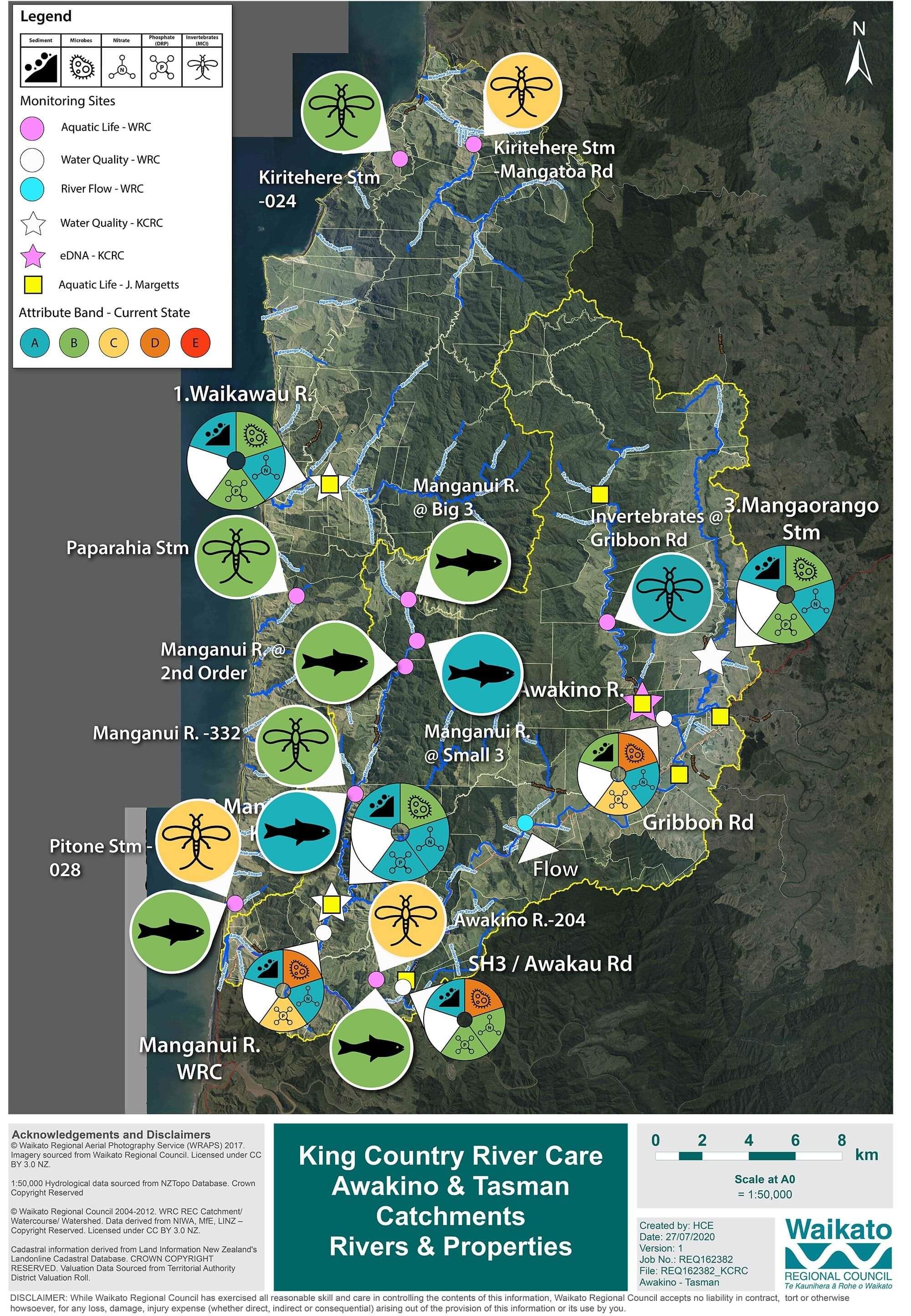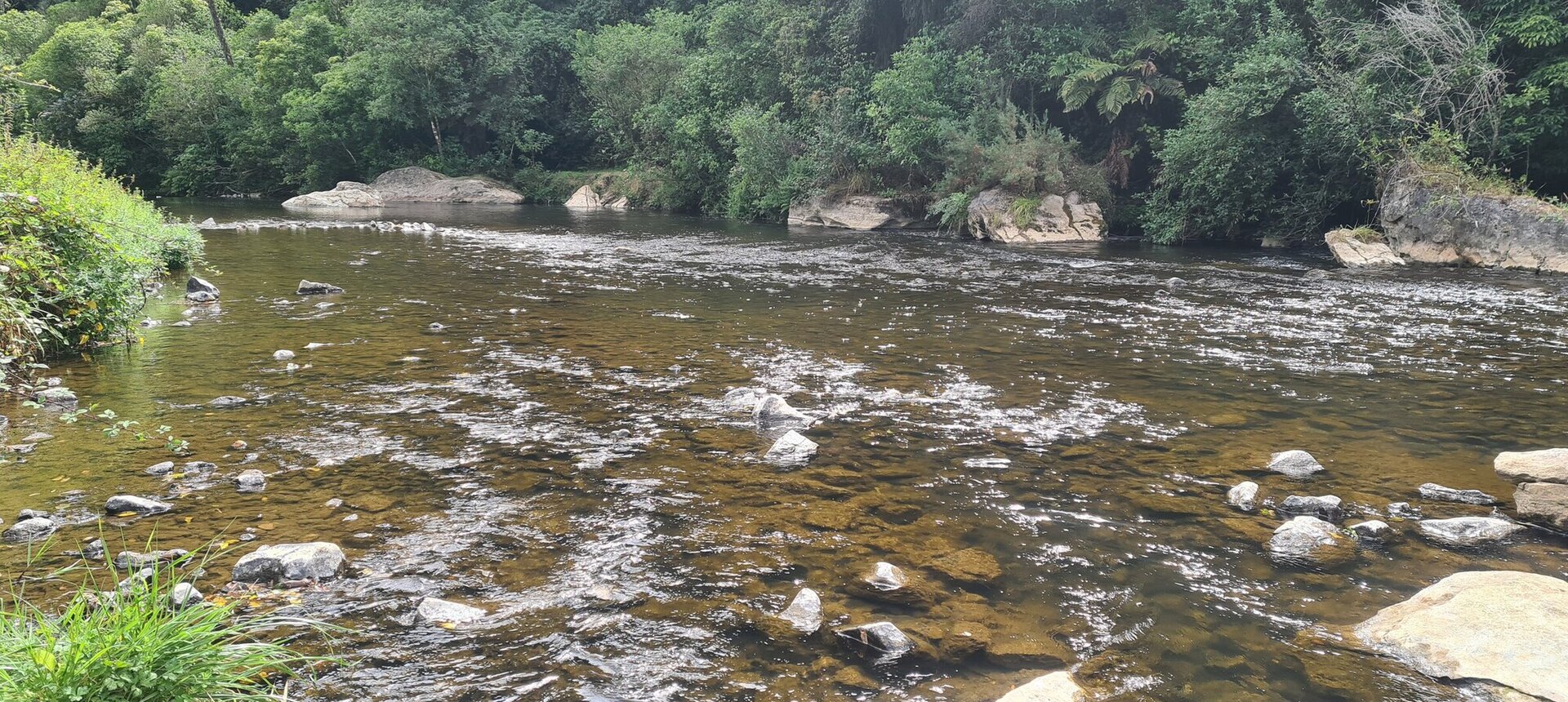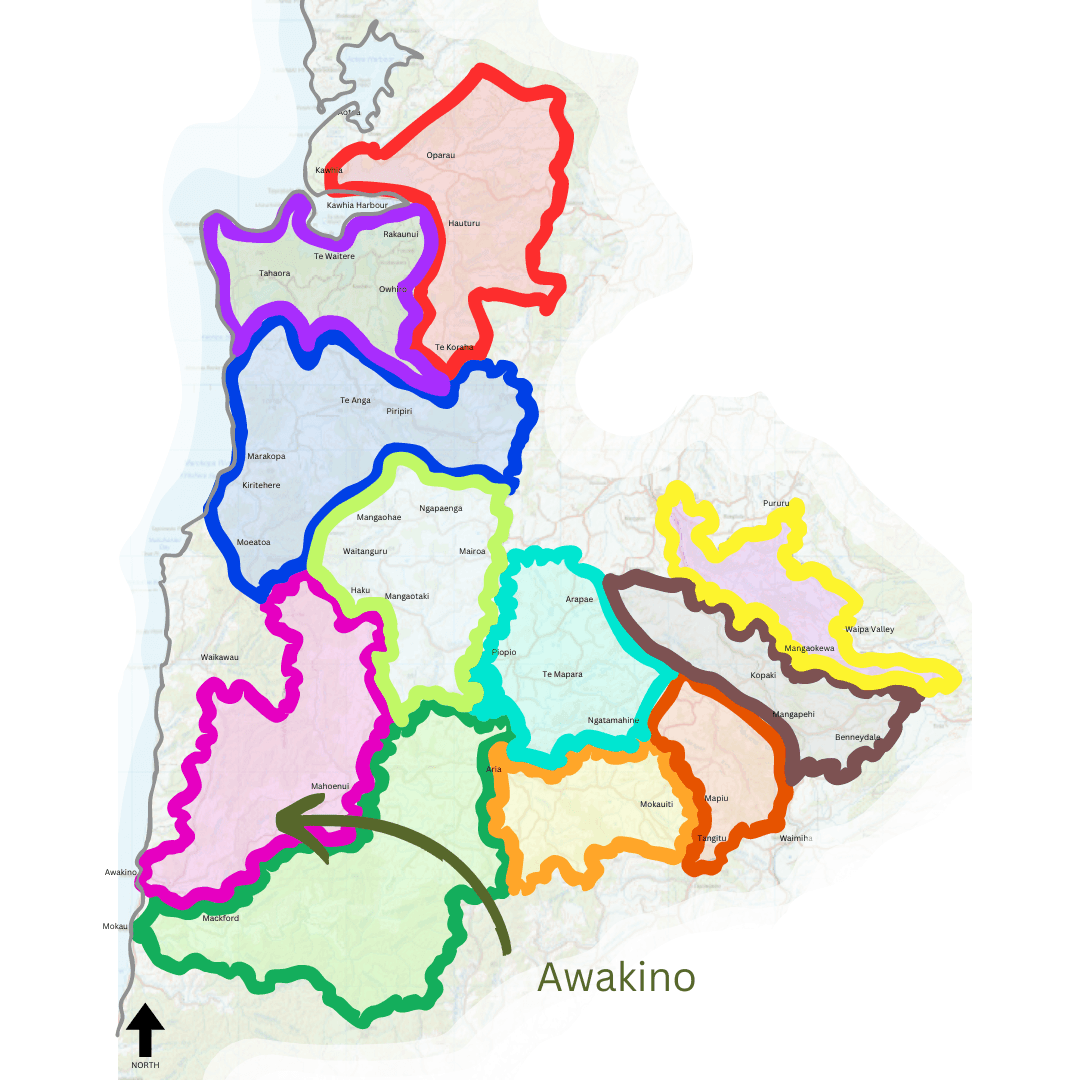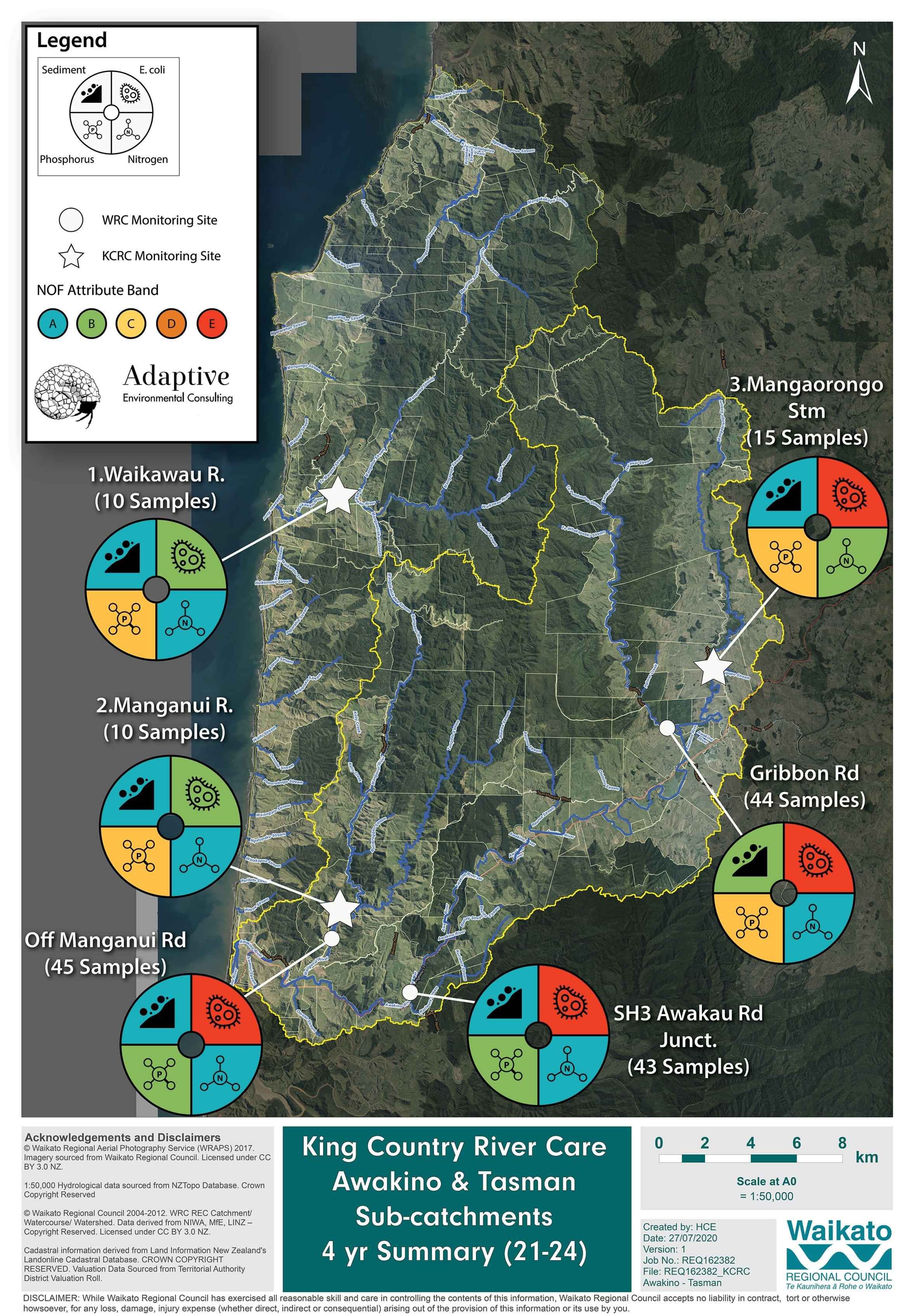2025 Quarterly Results
August 2025
Water quality was Excellent in Mangaorongo stream (Site 3).
E. coli concentrations were very low (120 cells per 100 mL), falling well within health guidelines for swimming (540 cells per 100 mL).
Nitrogen: Nitrate concentrations were very low (0.17 mg/L), falling well below the ecological toxicity threshold (2.4 mg/L). Ammonia concentrations were also very low (0.009 mg/L). Dissolved inorganic nitrogen (DIN) was corresponding very low (0.18 mg/L), falling well below the ecological impact threshold (0.5 mg/L).
Phosphorus: Dissolved reactive phosphorus (DRP) was very low (0.003 mg/L).
Suspended sediment/Water Clarity: Water clarity was Excellent (1.45 m), relative to the national bottom line (0.61 m).
The results in the table below have been graded according to the National Policy Statement for Freshwater Management (NPS-FM, 2020).
Sample Collection Date: 25th August 2025

River Level and Flow Rate – Awakino River Rauroa Farm Bridge
The below chart presents continuous data collected by the Waikato Regional Council for Awakino river between 1st January and 26th August 2025. River Level and Flow Rate on the day of sampling (25-August) are highlighted.
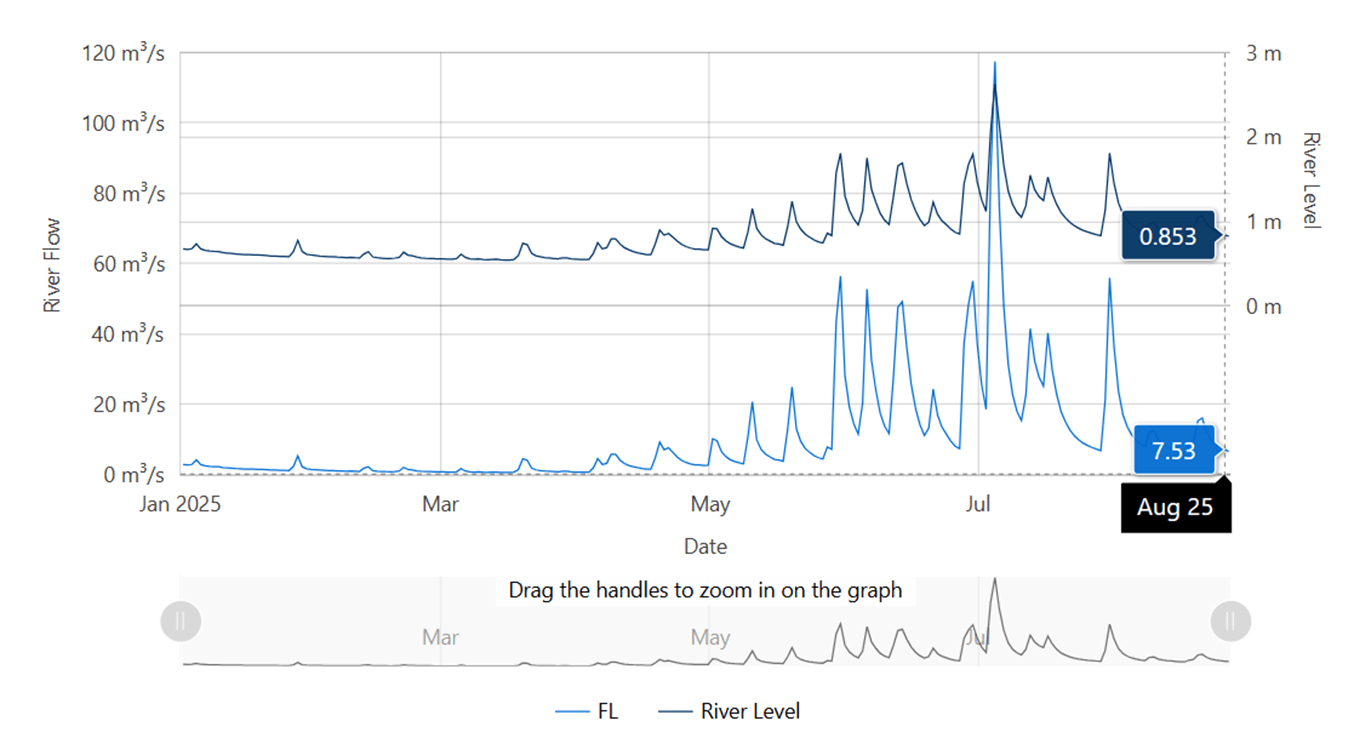
Data source: Waikato Regional Council envirohub website for environmental data.
May 2025
Water quality was Excellent in Mangaorongo stream (Site 3).
E. coli concentrations were very low (110 cells per 100 mL), falling well within health guidelines for swimming (540 cells per 100 mL).
Nitrogen: Nitrate concentrations were very low (0.10 mg/L), falling well below the ecological toxicity threshold (2.4 mg/L). Ammonia concentrations were also very low (<0.005 mg/L). Dissolved inorganic nitrogen (DIN) was corresponding very low (0.10 mg/L), falling well below the ecological impact threshold (0.5 mg/L).
Phosphorus: Dissolved reactive phosphorus (DRP) was very low (0.004 mg/L).
Suspended sediment/Water Clarity: Water clarity was Excellent (1.97 m), relative to the national bottom line (0.61 m).
The results in the table below have been graded according to the National Policy Statement for Freshwater Management (NPS-FM, 2020).
Collection date: 15th May 2025

River Level and Flow Rate – Awakino River Rauroa Farm Bridge
The below chart presents continuous data collected by the Waikato Regional Council for Awakino river between 1st January and 16th May 2025. River Level and Flow Rate on the day of sampling (15-May) are highlighted.
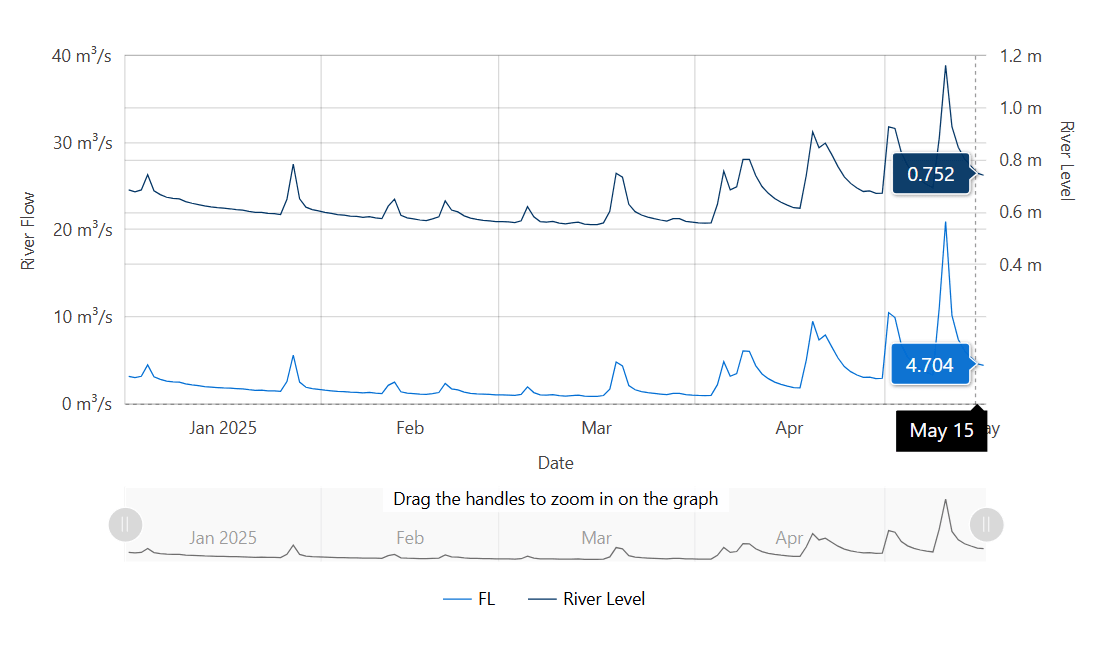
Data source: Waikato Regional Council envirohub website for environmental data.
February 2025
Water quality was Fair in Mangaorongo stream (Site 3).
E. coli concentrations were elevated (620 cells per 100 mL), exceeding recommended health guidelines for swimming (540 cells per 100 mL).
Nitrogen: Nitrate concentrations were moderate (0.53 mg/L), falling well below ecological toxicity levels (2.4 mg/L). Ammonia concentrations were low (0.009 mg/L). Dissolved inorganic nitrogen (DIN) was slightly elevated (0.54 mg/L), falling above the ecological impact threshold (0.5 mg/L).
Phosphorus: Dissolved reactive phosphorus (DRP) was very low (0.005 mg/L).
Suspended sediment/Water Clarity: Water clarity was excellent (3.13 m), relative to the national bottom line (0.61 m).
The results in the table below have been graded according to the National Policy Statement for Freshwater Management (NPS-FM, 2020).
Collection date: 27th February
River Level and Flow Rate – Awakino River Rauroa Farm Bridge
The below chart presents continuous data collected by the Waikato Regional Council for Awakino river between 1st January and 28th February 2025. River Level and Flow Rate on the day of sampling (27-Feb) are highlighted.
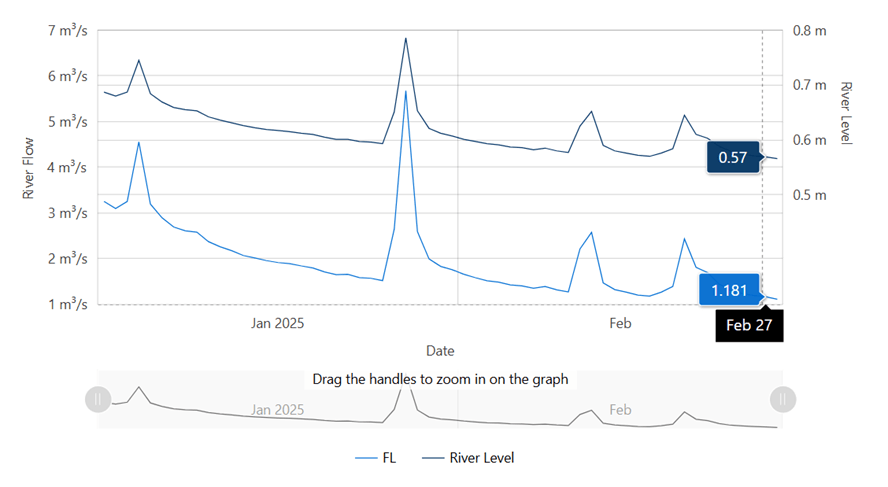
Data source: Waikato Regional Council envirohub website for environmental data.
Catchment monitoring by King Country River Care commenced in 2021. Initially, monitoring by KCRC covered three monitoring sites, sampled on a quarterly basis. In 2023 the number of KCRC sites was decreased to one site at Mangaorongo Stream. In addition, the Waikato Regional Council (WRC) has three monitoring sites in the Awakino & Tasman, which are monitored monthly. A water quality baseline was calculated from the time the catchment group was formed using five years (Jan 2015 – Dec 2019) of monthly monitoring data, collected at the three WRC sites. The location of the 6 monitoring sites in Awakino & Tasman are shown on Map 1 (see page 2).
2024 represents the fourth consecutive year of catchment monitoring. Water samples were collected on 14 Feb, 13 May, 22 August and 18 November, during stable weather to avoid any significant rainfall events. River flow strongly influences water quality and the river flow hydrograph for Awakino River.
Key Resources Being Lost from the Land
Monitoring results show the key resources being lost from the Awakino and Tasman catchments in 2024 were E. coli and dissolved reactive phosphorus (DRP). E. coli was elevated in 50% of sites and DRP was slightly elevated at all sites. Loss of DRP represents a loss of nutrients while elevated E. coli represents a loss of organic matter and nutrients as it is largely associated with animal manure in rural catchments.
The below water quality dials summarise the results collected in the Awakino & Tasman catchment. The dial on top shows the baseline for the catchment, covering 5 years of regional council monitoring at three sites in the Awakino Catchment (off Manganui Road, Awakau Road junction and Gribbon Road). The second dial below combines all data collected in 2024 and four sites, 37 samples in total. Arrows indicate either an increase or decrease in values compared to the sub-catchment baseline. An increase in water clarity is positive for river health while an increase in all other indicators may impair river health.
In 2024, nutrient indicators and water clarity/suspended sediment met national water quality limits while E. coli did not. Compared to the baseline – Water clarity was lower in 2024 and the concentration of dissolved reactive phosphorus was slightly higher.
Full Report Available to Download
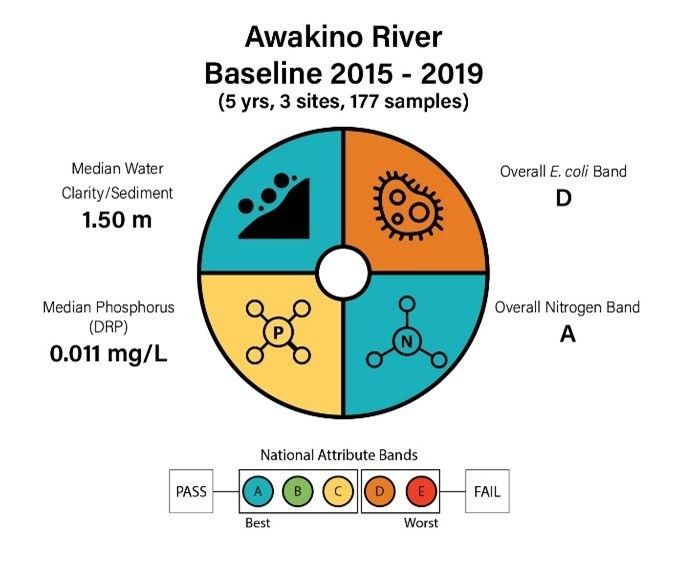
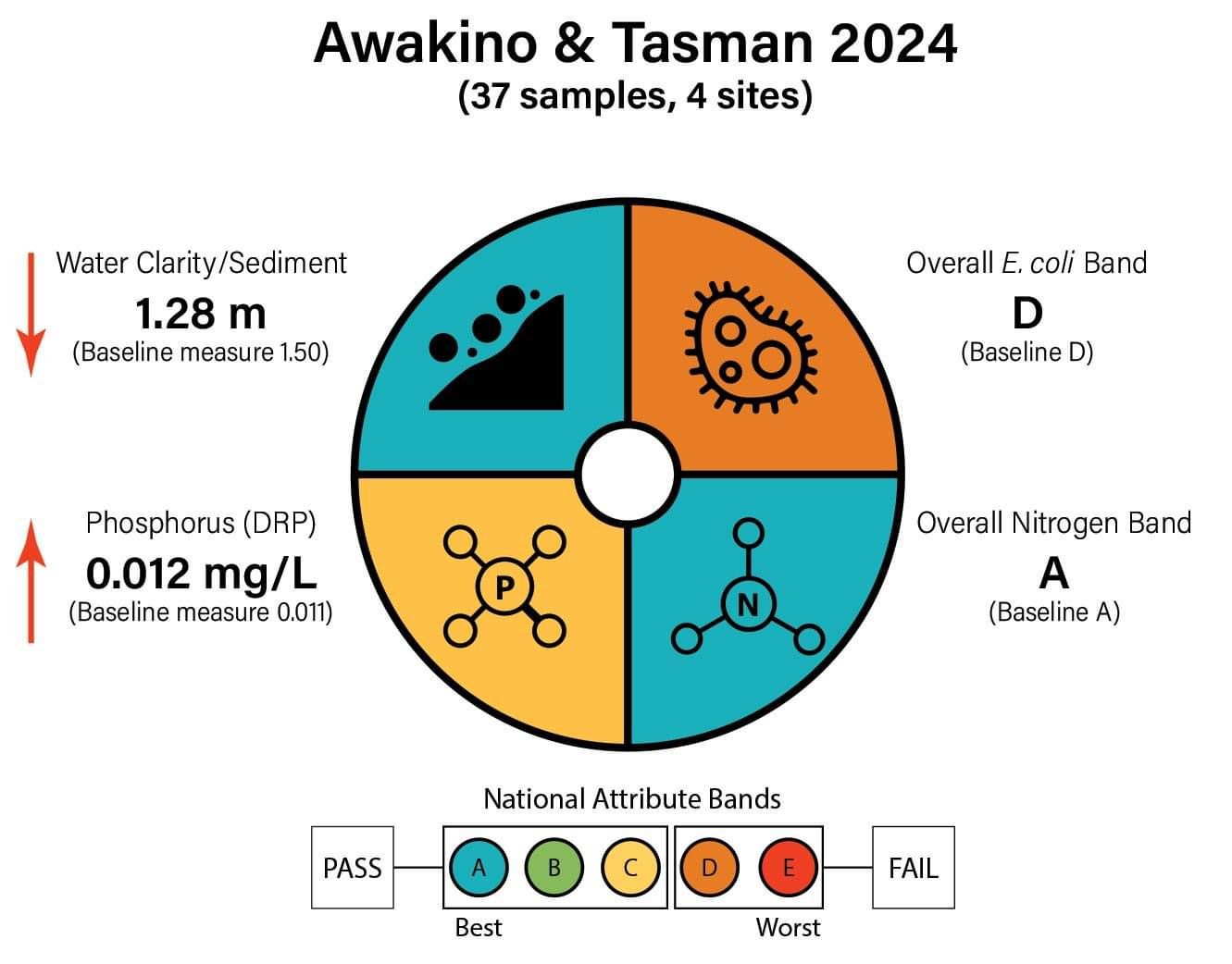
Figure 1. Water quality dials for the five sites in the Awakino & Tasman catchment. The dial on top shows the sub-catchment baseline (2015-2019) and the second dial combines results collected in the 2024 monitoring period.
2024 Quarterly Results
November 2024
Overall, water quality at Mangaorongo stream was Fair. E. coli was very high and dissolved reactive phosphorus was slightly elevated.
E. coli was very high (5,100), falling above the recommending health levels for swimming (540). Nitrate and Ammonia concentrations were low, falling well below levels which can cause ecological toxicity impacts (Nitrate 2.4 mg/L; Ammonia 0.24 mg/L). Dissolved inorganic nitrogen was low (0.40 mg/L), below concentrations considered as potentially impacting ecological health by promoting excessive growth of algae, aquatic plants and impacting sensitive aquatic species. Dissolved reactive phosphorus was slightly elevated (0.011 mg/L). Water clarity was excellent (0.95 m), relative to the national bottom line (0.61 m), indicating relatively low concentrations of suspended sediment.
Sample Collection Date: 12th November

May 2024
Overall, water quality at Mangaorongo stream was Good, except for Dissolved Inorganic Nitrogen, which was slightly elevated.
E. coli concentrations were low (210), falling within recommending health levels for swimming (540). Nitrate and Ammonia concentrations were well below levels which can cause ecological toxicity impacts (Nitrate 2.4 mg/L; Ammonia 0.24 mg/L). Dissolved inorganic nitrogen was slightly elevated (0.59 mg/L), potentially impacting ecological health by promoting excessive growth of algae, aquatic plants and impacting sensitive aquatic species. Dissolved reactive phosphorus was low (≥ 0.01 mg/L). Water clarity was good (0.91 m), relative to the national bottom line (0.61 m), indicating relatively low concentrations of suspended sediment.
Collection date: 12th June 2024


March 2024
Overall, water quality at Mangaorongo stream was Good, except for E. coli. E. coli concentrations were elevated (700) above recommending health levels for swimming (540). Nitrate and Ammonia concentrations were well below levels where ecological toxicity impacts occur (Nitrate 2.4 mg/L; Ammonia 0.24 mg/L). Dissolved inorganic nitrogen was low (0.43 mg/L)[1]. Dissolved reactive phosphorus was also low (≥ 0.01 mg/L). Water clarity was excellent (1.28 m), relative to the national bottom line (0.61 m), indicating low concentrations of suspended sediment.
Collection date: 26th March
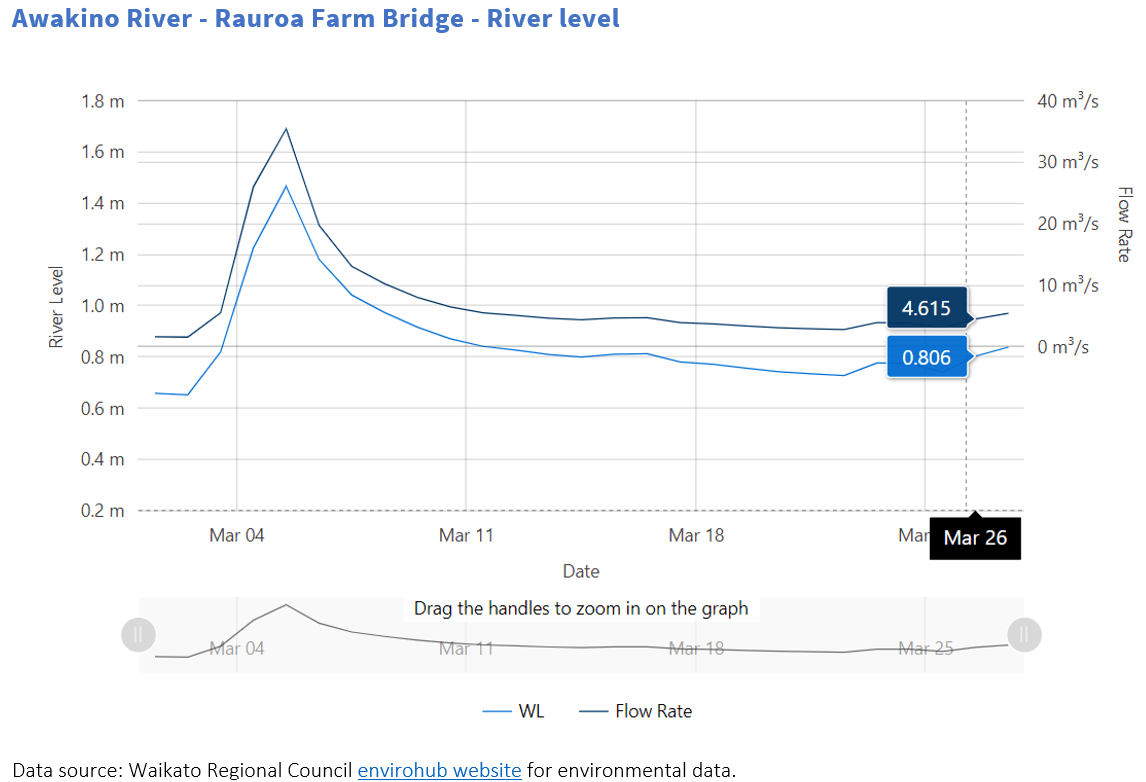
Water Quality
2023 Summary
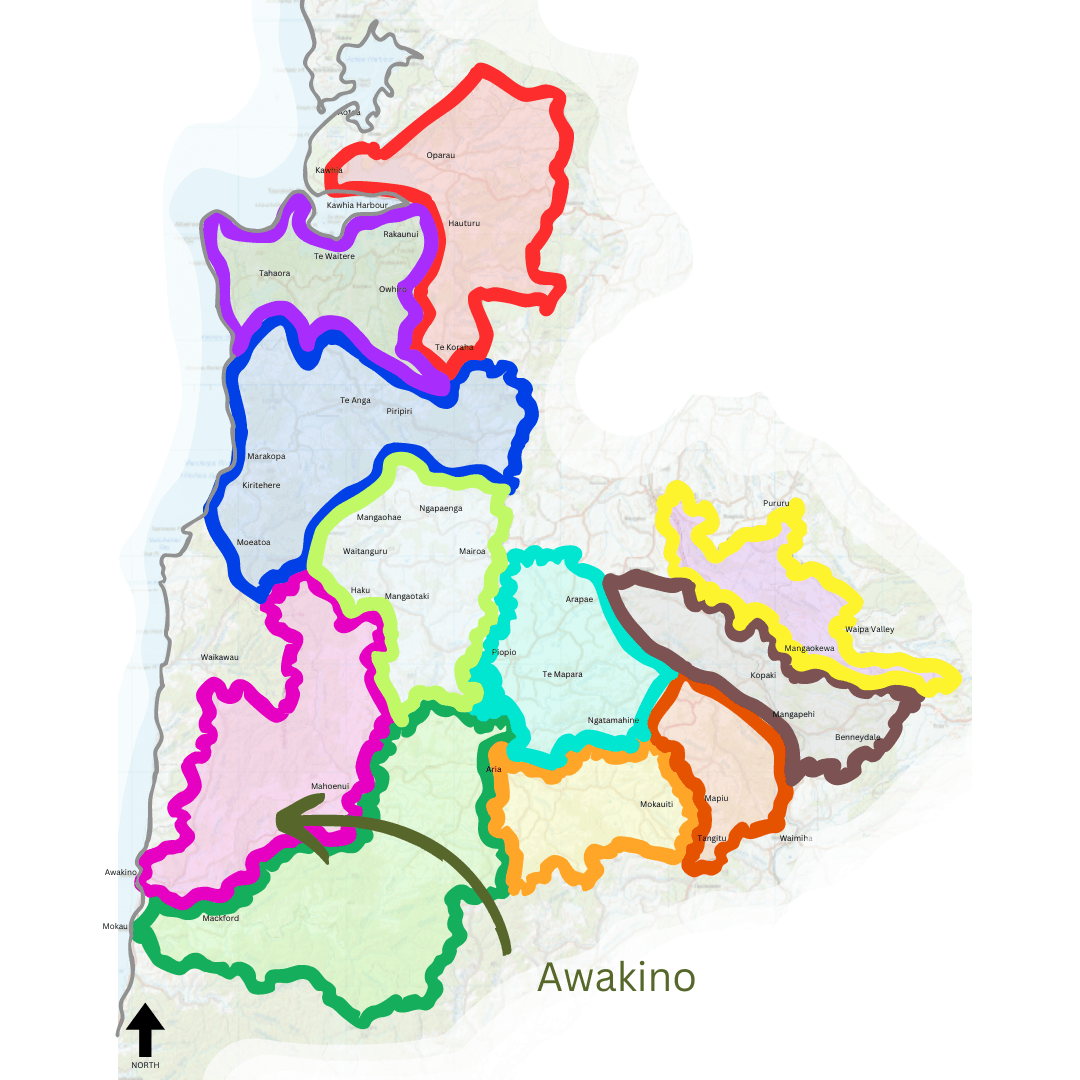
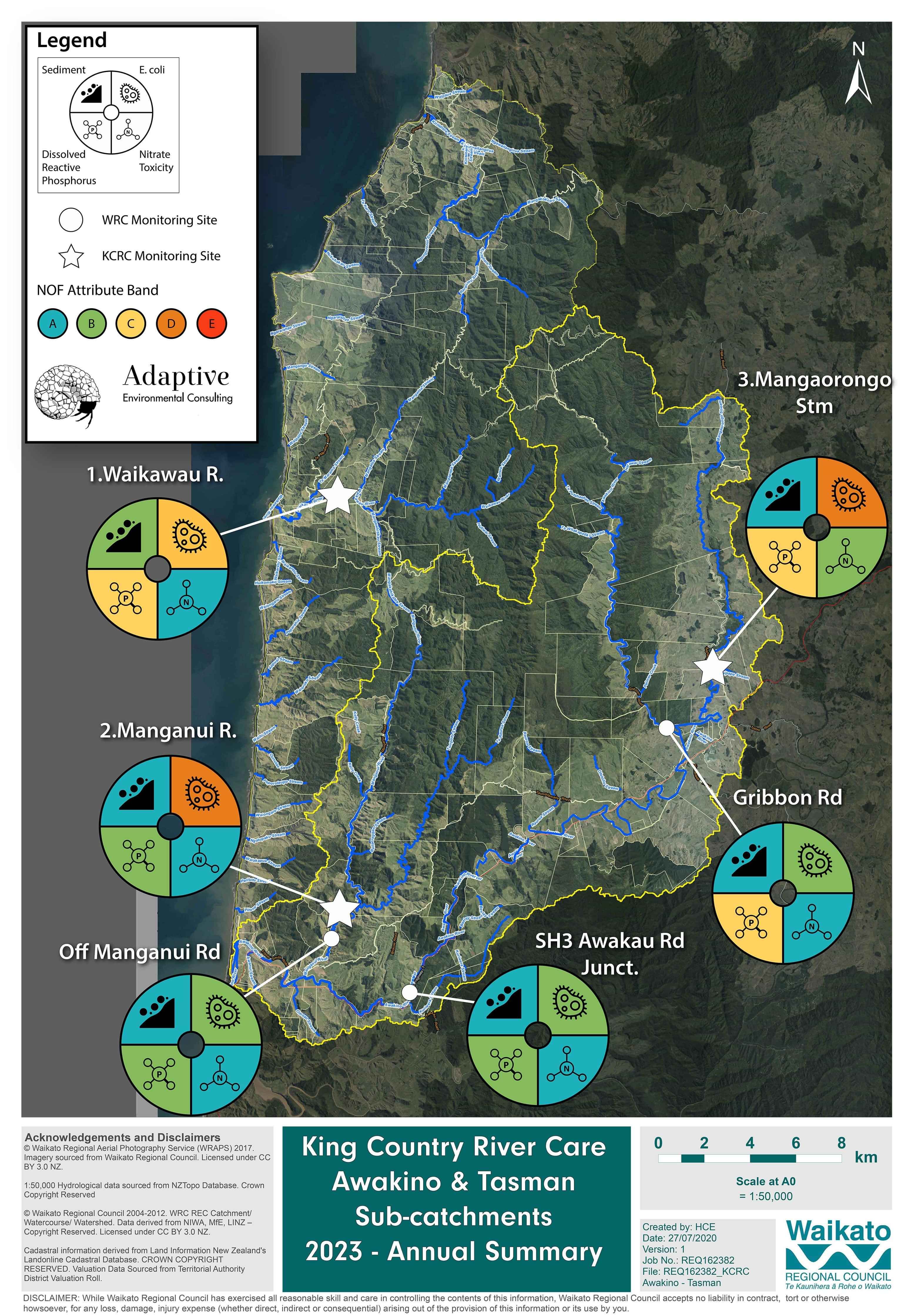
Water samples were collected from 6 stream and river sites across Awakino and Tasman. The monitoring sites were located on Waikawau River, Manganui River, Mangaorongo stream and the Awakino River. The below water quality dial summarises the results from 41 individual samples collected across 6 sites, between January 2023 and December 2023.
E. coli was slightly elevated which may pose a slight risk to human health when swimming. Dissolved reactive phosphorus (DRP) was low and nitrogen and suspended sediment were very low, which supports river health. All attributes met national water quality standards.
Arrows indicate an increase or decrease in values compared to the baseline. The baseline was calculated from 5 years of data collected by Waikato Regional Council at Awakino River and Manganui River, between 2015 and 2019. An increase in water clarity is positive for river health, while an increase in all other attributes may impair river health.
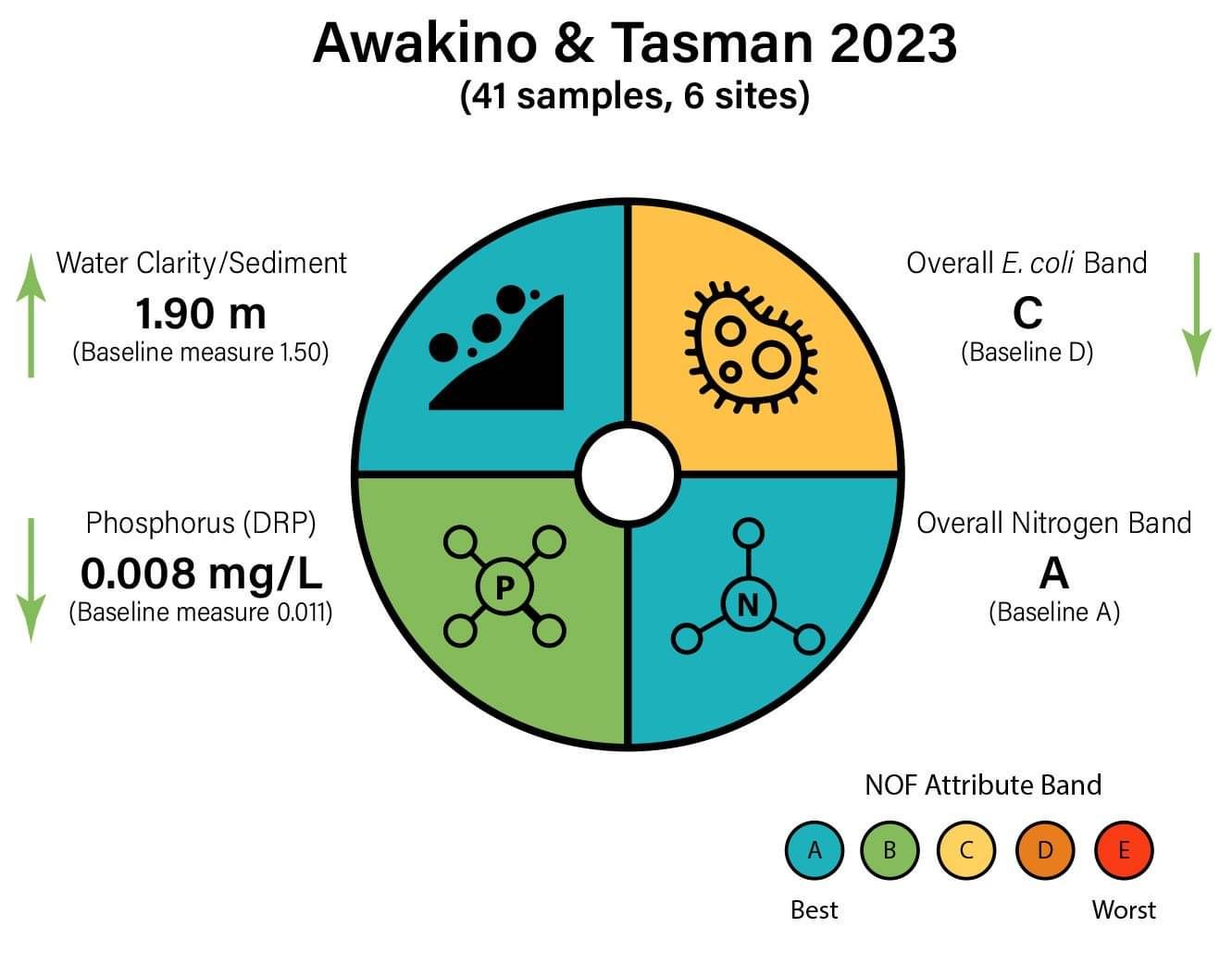
Aquatic Biodiversity Summary
Biodiversity monitoring includes eDNA, collected by KCRC, and traditional biodiversity monitoring techniques (netting of freshwater invertebrates and netting and electrofishing of freshwater fish), by Waikato Regional Council (WRC). eDNA sampling has been done by KCRC, in autumn and winter in 2021, 2022 and 2023. WRC monitors most sites every 1 to 2 years, between November and March. If more than one results is available for any single monitoring location the results for that site are averaged across years.
Awakino Tasman
Awakino & Tasman have outstanding ecological value!
A high number of insect species detected in eDNA in Awakino river, 64 species, an indicator for ecological health.
Good freshwater invertebrate MCI scores were seen at most monitoring sites.
Native freshwater mussels, a rare invertebrate species and filter feeder, were detected in Keritehere stream.
The fish community is diverse across most sites with numerous rare native species including all 5 species of whitebait (Shortjaw kōkopu, Giant kōkopu, Banded kōkopu, īnanga & kōaro).
Except for banded kōkopu, all species of whitebait are threatened with extinction and declining in number, nationally.
Numerous rare and threatened native fish species were detected including lamprey, redfin bully, longfin eel and torrent fish detected in catchment, another threatened species.
Only 1 species of introduced fish was detected, brown trout.
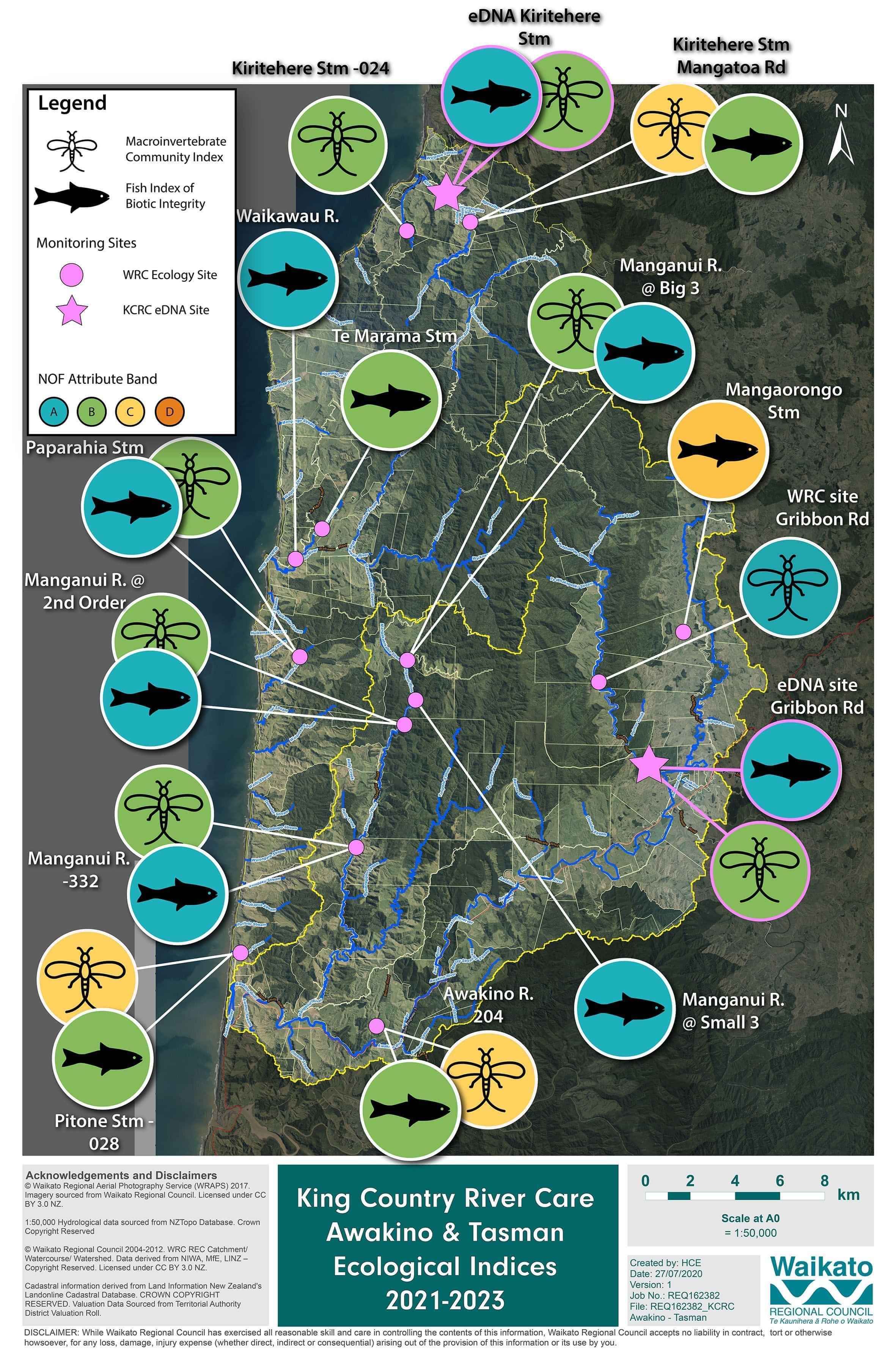
2023 Quarterly Results
November 2023
Overall, water quality at Mangaorongo stream was fair on 14th November 2023. E. coli concentrations were slightly elevated (350). Nitrate and Ammonia concentrations were well below toxicity levels (Nitrate 0.53 mg/L; Ammonia 0.005 mg/L). Dissolved Inorganic Nitrogen (DIN) was slightly elevated (0.54 mg/L), potentially impacting river health[1]. Dissolved reactive phosphorus was also slightly elevated (≥ 0.013 mg/L). Water clarity was excellent (3.38 m) relative to the national bottom line (0.61 m).
Collection date: 14 November 2023

September 2023
Overall, water quality at Mangaorongo stream was good on 11th September, except for a slightly elevated concentration of Dissolved Inorganic Nitrogen. E. coli concentrations were low (120). Nitrate concentrations were well below toxicity levels (0.61 mg/L). Ammonia concentrations were exceptionally low (< 0.005 mg/L). Dissolved Inorganic Nitrogen (DIN) exceeding 0.5 mg/L, potentially impacting the health of the river1 . Dissolved reactive phosphorus was low (≥ 0.008 mg/L). Water clarity was excellent (1.55 m), relative to the national bottom line (0.61 m).
Collection date: 11 September 2023
May 2023
E. coli concentrations were low at all sites (≤ 96). Nitrate concentrations were well below toxicity levels at all sites being lowest at 1-Waikawau River and 2- Manganui River (≤ 0.08 mg/L) and greater at 3-Mangaorango Stream (0.63 mg/L). Ammonia concentrations were low at all sites (≤ 0.007 mg/L). 3- Mangaorango Stream had a Dissolved Inorganic Nitrogen (DIN) concentration exceeding 0.5 mg/L, potentially impacting the health of the river1 . Dissolved reactive phosphorus concentrations were elevated at all sites (≥ 0.011 mg/L). Water clarity was excellent at 2-Manganui River and 3-Mangaorango Stream (≥0.99 m) but was poor at 1-Waikawau River (0.46 m), relative to the national bottom line (0.61 m).

February 2023
2022 Summary
The water quality dial for Awakino & Tasman combines data collected at 6 monitoring sites between January – December 2022, representing 47 individual samples. Nitrate was low, while water clarity was high, indicating low concentrations of suspended sediment. E. coli was elevated and dissolved reactive phosphorus (DRP) was slightly elevated. Arrows indicate an increase or decrease in values compared to the sub-catchment baseline (2015 – 2020). An increase in water clarity is positive for river health while an increase in all other attributes may impair river health.
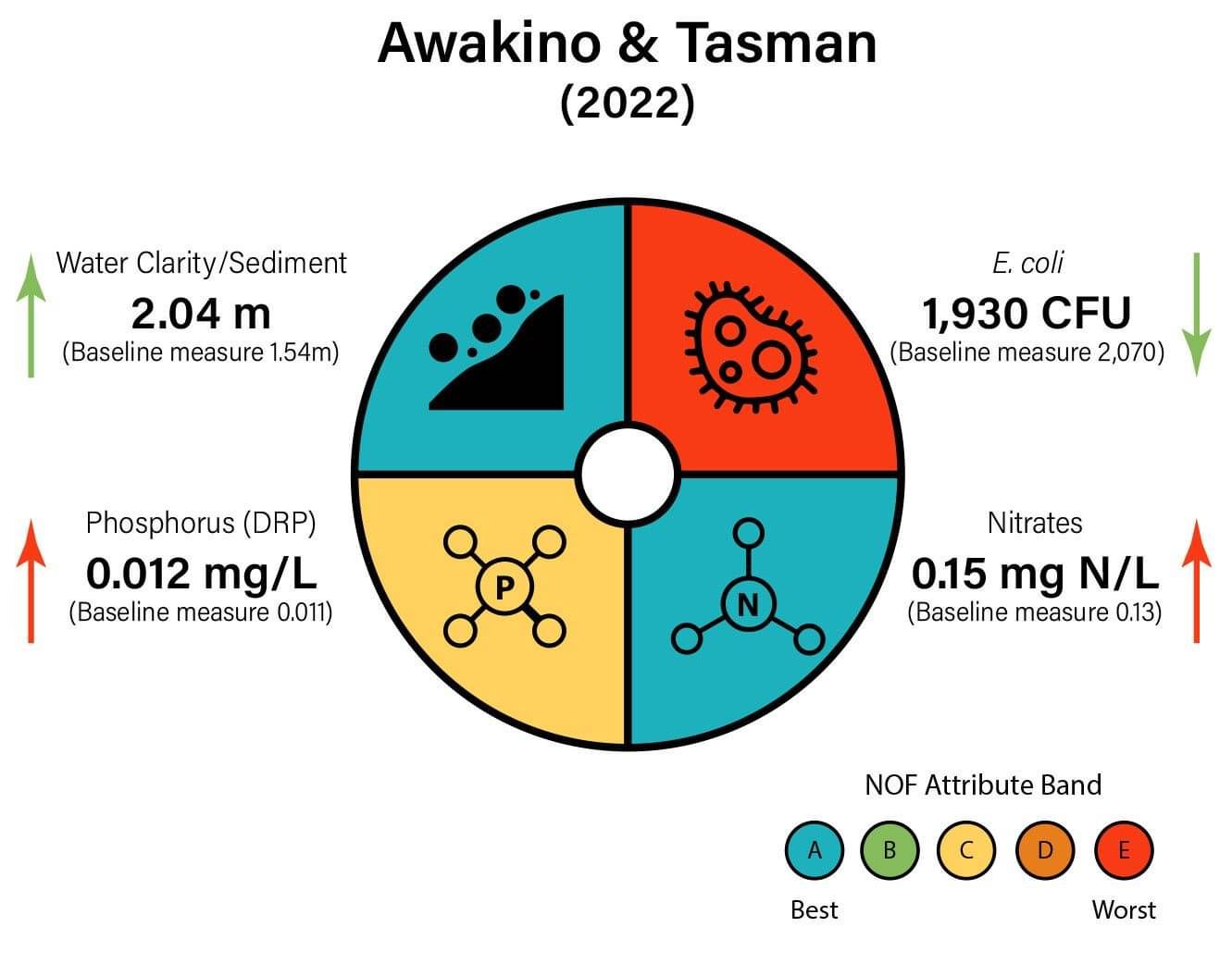
2021 Summary
E. coli and DRP are the main contaminants of concern.
Sediment appears to be elevated in the upper Awakino River, reflected by measurements taken at Gribbon Road.
Overall, those sites monitored by WRC exhibited higher E. coli concentrations compared to KCRC sites. This may relate to the greater number of samples collected at WRC sites, capturing seasonal peaks in more detail.
Over all sites in Awakino River and Tasman – Manganui River is the cleanest site and Gribbon Road is the poorest performing site.
Attribute bands
A (or blue is the best) through to E (red) which is the worst.
